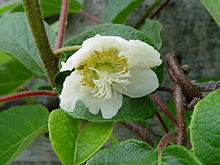Actinidiaceae
| Actinidiaceae | |
|---|---|
 |
|
| Actinidia deliciosa | |
| Scientific classification | |
| Kingdom: | Plantae |
| (unranked): | Angiosperms |
| (unranked): | Eudicots |
| (unranked): | Asterids |
| Order: | Ericales |
| Family: |
Actinidiaceae Gilg & Werderm. |
| Type genus | |
|
Actinidia Lindl. |
|
| Genera | |
The Actinidiaceae are a small family of flowering plants commonly known as the Chinese gooseberry family. The family has three genera and about 360 species and is a member of the order Ericales.
They are temperate and subtropical woody vines, shrubs, and trees, native to Asia (Actinidia or kiwifruit, , and Saurauia) and Central America and South America (Saurauia only). Saurauia, with its 300 species, is the largest genus in this family. Although now confined to Asia and tropical Central and South America, evidence indicates in the past the family had a wider distribution. The now extinct genus Parasaurauia is thought to have belonged to the Actinidiaceae and lived in North America during the early Campanian.
The plants are usually small trees or shrubs, or sometimes vines (Actinidia). The alternate, simple, spiral leaves have serrated or entire margins. They lack stipules or are minutely stipulated. They are often beset with rather flattened bristles.
The flowers grow solitary or are aggregated in terminal cymes, with free sepals and petals. Except for members of the genus Clematoclethra which have 10 stamens, the stamens are numerous and originally attached at the back. They invert just before the flower starts expanding, so their bases become apical.
The plants may be dioecious, monoecious, or hermaphroditic. The fruit is usually a berry, such as the edible kiwifruit, a cultivar from the genus Actinidia.
...
Wikipedia
